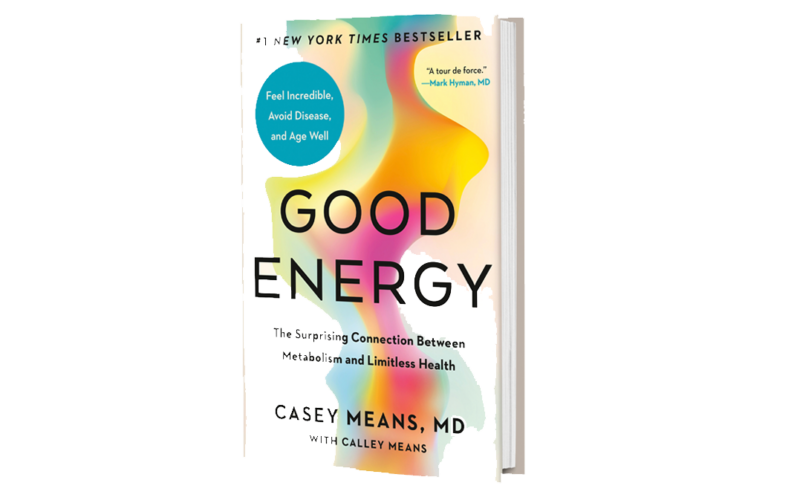What if all of the most common medical issues in our country — including diabetes, depression, infertility, cancer, heart disease, and even Alzheimer’s — stemmed from the same root cause? This is the main premise of Good Energy by Dr. Casey Means. In Good Energy, Means reveals what this cause is (hint: it’s metabolic health!) and how we can help our cells make more “good energy” instead of the “bad energy” largely caused by modern life. In this Good Energy book review, I share my take on whether or not it’s a must-buy for those looking to improve their overall health.
Casey Means, MD, is a Stanford-educated, former ear, nose, and throat (ENT) surgeon. Her work as a hospital surgeon exposed her to the brokenness of the medical system, prompting her to learn more about metabolic health and how to prevent the very diseases so many of her surgical patients suffered from. Means is also the co-founder of Levels, an app which connects with a continuous glucose monitor (CGM) to allow users to track their blood sugar levels in real time.
Good Energy was co-written with Means’ brother, Calley Means, an entrepreneur and the founder of TrueMed, a company that enables tax-free FSA or HSA spending on supplements, exercise, and food. Calley and Casey lost their mother to pancreatic cancer in 2021, which was a huge ‘aha’ moment for both of them in wanting to learn more about metabolic health and longevity.
Who is the intended audience of Good Energy?
Good Energy is meant for any reader interested in learning more about their health and feeling better.Those struggling with chronic issues like diabetes or hypertension stand to gain the most from the advice offered here, as it speaks directly to the root cause of their problems and offers concrete solutions to move forward. Those who are generally healthy will also benefit from reading Good Energy, as it offers advice for taking your health from just being ‘okay’ to truly optimal. Readers can pick and choose which parts of the Good Energy plan most relate to their lives.
What are the main content areas of Good Energy?
Good Energy opens with a vivid description of some of the patients Means encountered in her work as an ENT surgeon. Many of these patients were on multiple medications, visited a wide variety of specialists annually, and had a plethora of health struggles. Realizing that these patients must have a root cause of their ailments led Means to zoom into the cell (as it is the most basic building block of life) to understand how it makes and uses energy.
This gave rise to her framework: cells can either make ‘Good Energy’ or ‘Bad Energy’, depending on what inputs they are given. Many aspects of modern American life (such as our over-abundance of and reliance on ultra-processed food, sedentary lifestyles, chronic stress, environmental toxins, and lack of sleep and outdoor time) all increase the ‘Bad Energy’ in our cells, leading to inflammation and disease. In other words, these negative elements all vastly hurt our metabolic function, leading to metabolic diseases which can ultimately be deadly. This idea is not news to our Natural Womanhood readers, as we’ve covered the connection between metabolic health and chronic diseases, including reproductive issues.
The first section of the book delves into the ways so many people struggle with ‘Bad Energy’ in our cells, and Means also draws on her clinical experience to discuss how our current medical system does not seek to prevent chronic disease.
The bulk of the book is dedicated to describing how we can create more ‘Good Energy’ instead, with a framework of diet and lifestyle. This includes exercise, light exposure at different times of day, time spent outdoors, and eliminating toxins from household products. Finally, Means provides a four-week plan to enact these changes, with a handful of recipes to try along the way.
Strengths of Good Energy
Overall, Good Energy is a fantastic beginner-level exploration into why many Americans are getting so sick. Means’ ‘Good Energy’ versus ‘Bad Energy’ framework is easy to understand and gives the reader insight into elements of cell biology that might have previously been inaccessible to the average layman. Many elements of her book were similar to Dr. Peter Attia’s Outlive, in my opinion, but Good Energy was a simpler read and probably more approachable for someone new to these topics.
The other element I loved was how she broke down her Good Energy plan into actionable steps that seemed attainable. In her four-week plan, Means tells readers to start by examining which areas of their life may be producing bad energy. She shifts to focus largely on diet, and then turns to the other elements of increasing Good Energy, choosing just a few action steps for the remaining weeks. This is a great way to not feel burdened or burnt out by making a health change. Means also includes multiple checklists that readers can follow to figure out if they are metabolically healthy or not.
Good Energy’s limitations or blindspots
There were a handful of issues I found in Good Energy.
Lack of specifics on when and how to track biomarkers
Means highly recommends tracking biomarkers as a cornerstone of improving your health, including heart rate, activity, sleep trackers, and recording every bite of food you eat. While these actions can be extremely beneficial and give us valuable information about our health, she doesn’t make any mention about when you should stop doing these things. Obsessive tracking (especially of food) is unsustainable in the long-term, and may lead to disordered eating if done indefinitely [1].
Additionally, while Means recommends quitting hormonal birth control, she doesn’t mention the value of tracking the biomarkers of your menstrual cycle. This omission is disappointing since the menstrual cycle is a 5th vital sign of overall health for the female body and in fact irregular cycles in the teen years can predict metabolic dysfunction down the road.
Self-promotion
In addition to other biomarkers, Means recommends continuous glucose monitoring (CGM), and points to her company Levels as a great way to do this. Not only does this financially benefit her, Levels also costs $200 monthly plus a $200 annual fee to use the app — this sum is not exactly accessible to the average person.
Encouragement of experimentation with psychedelic substances
Means says to consider using psilocybin-assisted therapy — AKA, psychedelics or magic mushrooms (p. 256-258). She describes her own experience of being on mushrooms as laying in the desert feeling “one with the moon” (p.258). This is just one example of many New Age references in her book. I found the recommendation to use psychedelic drugs to be strange in a book focused on natural means of health and healing, but this section is easy to ignore.
Unnecessary rigidity in food recommendations
Additionally, Means’ food philosophy can be rigid and confusing. Her three biggest food rules are to cut out refined grains, industrial seed oils, and refined added sugars. These are all generally what we think of when we consider processed foods, and make sense to eliminate from our diets. However, in later sections Means says that she doesn’t recommend eating any grains (p. 175).
This struck me as odd, since human civilization has subsided on properly prepared (soaked or soured) grains for millenia. A homemade sourdough loaf made from freshly milled whole grain wheat is a lot different than highly processed white bread, yet Means does not distinguish between the two and offers no explanation as to why.
The verdict: To buy, borrow, or skip Good Energy?
I think Good Energy is a great pick to borrow from the library if you are new to metabolic health and curious about it. Means does a fantastic job of explaining the framework in a clear way, and her four week plan to build ‘Good Energy’ is a solid roadmap for beginning a health journey. However, I would probably pick Dr. Peter Attia’s Outlive over this book, because it goes more in-depth on the issues with our current medical system and offers more specific research on longevity.
If you’re looking for mostly nutritional advice, I would recommend picking up any book written by Lily Nichols (Real Food for Fertility is a great place to start if you’re a woman in your fertile years) or Deep Nutrition by Dr. Cate Shanahan over this book. Both of those authors have more expertise in nutrition specifically, and include extremely helpful, accessible meal plans and recipes.
That being said, Good Energy will help you understand your metabolism in a way you’ve perhaps never thought of before and is a great start for any beginner who is looking to take their health more seriously.
Additional Reading:
Natural Womanhood Book Review: Real Food for Fertility
PCOS and memory loss in midlife, is there a connection?
Irregular cycles in teen girls can predict future metabolic syndrome
References:
[1] Eikey EV. Effects of diet and fitness apps on eating disorder behaviours: qualitative study. BJPsych Open. 2021 Sep 24;7(5):e176. doi: 10.1192/bjo.2021.1011. PMCID: PMC8485346.











I’m reading the book now and find it interesting and potentially beneficial. What I find perplexing is the lack of citations for the numerous facts and studies that she speaks about. If the science behind her claims is to be believed, they need to be backed up with the citations where the reader can view the credibility of the source and delve deeper into the conclusions of they wish. I was truly disappointed not to find a bibliography/list of references at the end of the book.